Diffuse Large B-cell Lymphoma (DLBCL)
You are here
Definition
Diffuse Large B-cell lymphoma (DLBCL) the single largest category of lymphoma, is a heterogeneous group of malignant lymphomas with several morphologic features.
Sample Cases
Click here for instructions on how to download the free FCS Express Reader to view and manipulate the sample cases.
| Case Name (click on case name to open) |
Comments | Size |
| DLBCL1 | DLBCL | 1793.49 kB |
| case 33 | DLBCL This case was kindly provided by the ASCP Press. It is part of Flow Cytometry in Clinical Diagnosis by John Carey, Phil McCoy and David Keren. |
759 kB |
| case 30 | DLBCL This case was kindly provided by the ASCP Press. It is part of Flow Cytometry in Clinical Diagnosis by John Carey, Phil McCoy and David Keren. |
832 kB |
| case 37 | DLBCL This case was kindly provided by the ASCP Press. It is part of Flow Cytometry in Clinical Diagnosis by John Carey, Phil McCoy and David Keren. |
796 kB |
Epidemiology
DLBCL constitute 30-40% of the adult non-Hodgkin's lymphoma cases in western countries (higher incidence in developing countries). The median age is 70-80 years of age; however, can be seen in children. It is slightly more common in men. the incidence of DLBCL has increased over the last decade.
Possible causes
The cause remains unknown; however, can be a progression from other CLL/SLL. Underlying immunodeficiency may be a risk factor as well as EBV.
Morphology
DLBCL typically replaces the normal lymph node architecture in a diffuse pattern. Cytologically, are diverse and can be divided into the following morphologic variants: Centroblastic, Immunoblastic, T-cell/histiocyte rich and Anaplastic.
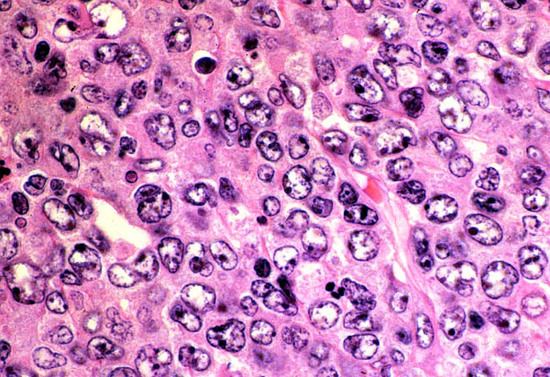 |
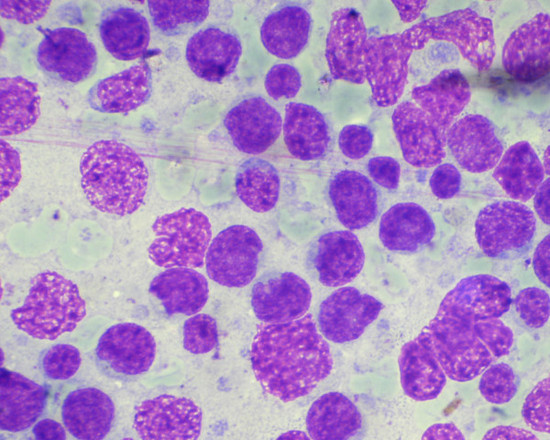 |
| H & E section of a DLBCL | Touch prep smear of DLBCL |
Immunophenotyping
When using fresh tissue for flow cytometric immunophenotyping, the predominant populations are lymphoid. these can be stratified as large and small lymphocytes (CD45 positive). The gating dot plot below identifies both a small (red) and large (green) subset of lymphocytes. Both subsets of cells were used in the subsequent anlaysis. DLBCL would fall in the large lymphocyte region as shown below.
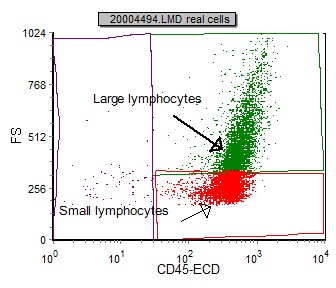 |
| The CD45 vs FS gating plot reveals both a small(red) and large (green) population of lymphocytes. |
Below is a table of common immunophenotyping markers used to identify and classify DLBCL.
| Marker | Expression in DLBCL |
| CD5 | -/rare + (de novo cases) |
| CD10 | +/- |
| CD19 | + |
| CD20 | +/very rare - |
| CD22 | + |
| CD23 | -/rare + |
| CD25 | -/rare + |
| CD30 | -/+ |
| CD43 | -/+ |
| CD45 | +/rare - |
| CD56 | -/rare + |
| CD79a | + |
| CD103 | -/rare + subset |
| bcl-1 | - |
| bcl-2 | +/- |
| bcl-6 | -/+ |
| Ki-67 | + |
| Light chain Ig (k or l) | + |
| TdT | - |
The following are selected examples of dual parameter dot plots from a case of DLBCL.
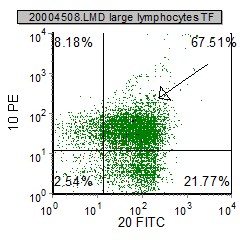 |
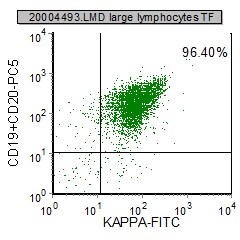 |
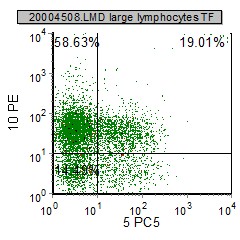 |
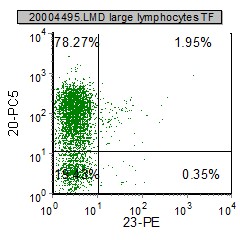 |
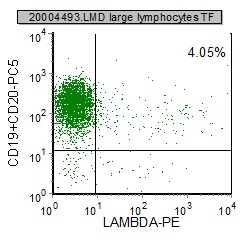 |
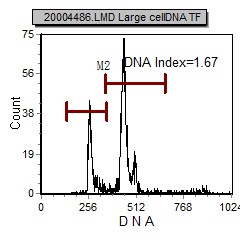 |
| DLBCL expresses CD20 and CD10, CD23 is absent. | DLBCL express CD19 with a monoclonal light chain restriction of either kappa or lambda. | CD5 is generally negative (can be partially positive in de novo cases). These cells are agressive with high proliferation, as seen by high SPF and aneuploidy. |
Other relevant tests
Cytochemistry: PAX-5 by immunohistochemistry is expressed in DLBCL.
Genetics: Most cases have rerranged heavy and light chain genes. Translocation of the bcl-2 gene (generally associated with FCL) can occur in 20-30% of cases of DLBCL. DNA microarray has identified two subgroups of DLBCL; Germinal center B-cell like (GCB), and activated B-cell like (ABC).
Sub-classification: Cytologically, DLBCL are diverse and can be divided into the following morphologic variants: Centroblastic, Immunoblastic, T-cell/histiocyte rich and Anaplastic. Gene expression analysis has identified two distinct biologic entities in DLBCL. The gene expression subgroups are: Germinal center B-cell like (GCB), and activated B-cell like (ABC).
Flow Diagnosis: DLBCL are CD45 positive and large (high FS) and express the pan B cell markers CD19, CD20, CD22 and CD79a. A surface light chain restriction of kappa or lambda is present. CD10 is usually present, though CD5 is only seen in de novo cases.
